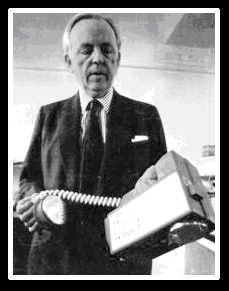Famous People
Series
This is the
second in a series of Caches to honour local people who have gained
International recognistion in the fields of Technology and the
Arts
JAMES FRANCIS
"FRANK" PANTRIDGE, MD, CBE
Soldier, Cardiologist & Inventor
1916 – 2004

Frank Pantridge was a physician
and cardiologist from Northern Ireland who transformed emergency
medicine and paramedic services with the invention of the portable
defibrillator, and was known worldwide as the "Father of Emergency
Medicine".
James Francis Pantridge (always
known as Frank) was born on October 3 1916 on the outskirts of the
village of Hillsborough, Co Down. His forebears were small
landowners. He was educated at the local Friends School and
graduated in Medicine from The Queen's University of Belfast in
1939. During World War II he served in the British Army and was
posted to the Far East where he became medical officer of an
infantry battalion. During the battle that preceded the fall of
Singapore, he received an immediate award of the Military Cross;
the citation stated that "this officer worked unceasingly under the
most adverse conditions of continuous bombing and shelling and was
an inspiring example to all with whom he came in contact. He was
absolutely cool under the heaviest fire ".
Captured at the fall of
Singapore, Pantridge spent much of his captivity in the slave
labour camps on the Siam-Burma Railway, including some months in
the notorious "death camp", Tanbaya, on the Siam-Burma border where
he had the tendons on his hands severed so that he would never
perform surgery again. He survived the usually fatal cardiac
beriberi, an experience which may have initiated his special
interest in heart disease.
After his liberation he worked
as a lecturer in the pathology department at Queen's University,
and then won a scholarship to the University of Michigan, where he
studied under Dr. F. N. Wilson, a cardiologist and authority on
electrocardiography. Frank Pantridge returned to Northern Ireland
in 1950, and was appointed as cardiac consultant to the Royal
Victoria Hospital, Belfast and professor at Queen's University,
where he remained until his retirement in 1982. There he
established a specialist cardiology unit whose work became known
around the world.
By 1957 Pantridge and his
colleague, Dr. John Geddes, had introduced the modern system of
cardiopulmonary resuscitation (CPR) for the early treatment of
heart attack. Further study led Frank Pantridge to the realization
that many deaths resulted from ventricular fibrillation which
needed to be treated before the patient was admitted to hospital.
This led to his introduction of the mobile coronary care unit
(MCCU), an ambulance with specialist equipment and staff to provide
pre-hospital care.
To extend the usefulness of
early treatment, Pantridge went on to develop the portable
defibrillator, and in 1965 installed his first version in a Belfast
ambulance. It weighed 70 kg and operated from car batteries, but by
1968 he had designed an instrument weighing only 3 kg,
incorporating a miniature capacitor manufactured for
NASA.
With these developments, the
Belfast treatment system, often known as the "Pantridge Plan",
became adopted throughout the world by emergency medical services.
The portable defibrillator became recognised as a key tool in first
aid, and Pantridge's refinement of the automated external
defibrillator (AED) allowed it to be used safely by members of the
public.
Although he was known worldwide
as the "Father of Emergency Medicine", Frank Pantridge was less
acclaimed in his own country, and was saddened that it took until
1990 for all front-line ambulances in the UK to be fitted with
defibrillators. He was awarded the CBE in 1978.
The
Cache
This is a
multi stage cache it starts at a tribute to the "Father of
Emergency Medicine" where you will get enough information to take
you to the cache. No suitable hiding place could be found in the
immediate facinity hence you have to walk to find your goal. The
terrain rating has been set to 1.5 to indicate that it may not be
suitable for wheelchair access, while most of the area is flat it
does involve steps to access the cache. The cache is a small
magnetic keysafe, so no room for trades or travelers, please bring
your own pencil.
Way Point
1
N54 30.690 W6 02.085
A =
The year John Sherlock signed the figure
B = The number of Rocks on the plinth with the
statue
C = The number of switches on the
Defrillator
D = Number of clips on the tie
E = The number of visable buttons on his jacket
minus C from above
The
Cache
N54 30.A(B+1)(C+1) W06 02.(D+1)DE
More in the
Series
1.
Sir Hamilton Harty
2. Professor Frank Pantridge
3. Oliver Hutchinson
4. Harry Ferguson